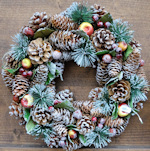
Expect no huge surprises when it comes to Christmas decorations in Vienna. But some differences exist between the local approach and the typical Anglo-American concepts familiar from home or Hollywood.
- Decorations tend to use more natural materials
- Tree candles, Advent wreaths, and St. Barbara’s twigs are popular traditions
- Pop into department stores just after Christmas for sales on commercial decorations
- Browse the Christmas markets for handcrafted alternatives
- Book a concert experience* for the Viennese Advent
- See also:
- Christmas (in Vienna)
- Christmas food
Style and tradition
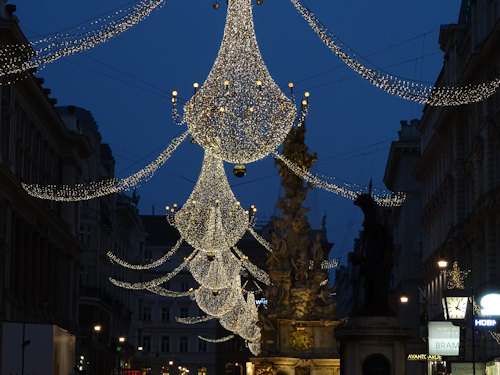
(Christmas lights on the Graben)
No ancient Austrian traditions insist we hang up wooden goat ears or an inflated pig bladder to ensure the Christkind brings the right gifts or to prevent satanic pixies spiking our Weihnachtspunsch.
(Though perhaps this is where I’ve been going wrong.)
You get a broad feel for the decoration culture in Vienna from the city’s own Christmas lights, where whites and yellows dominate. Or from the wares sold at the Christmas markets, which have a handcrafted, artisan feel.
In general, you find less plastic and more glass, wood, straw, and other natural materials here (with the exception of strings and strings of white LED lights).
Coming from the UK, the decorations strike me as more subtle and Victorianesque than in the country of my birth.
Having said that, you can still discover fluorescent Santas ho-ho-hoing their way through the starry Vienna night if you look hard enough. Many apartments, for example, place garish light displays in their windows or on balconies.
Here are three decorating traditions I found relatively new after my arrival here:
1. Baumkerzen (tree candles)
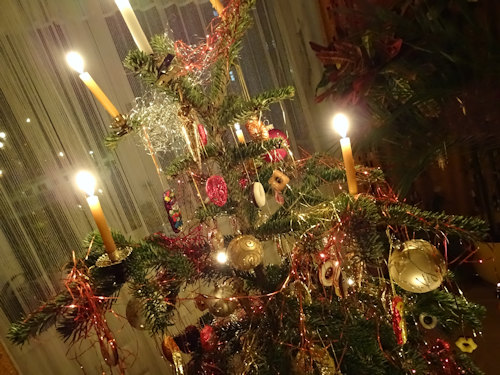
(A family tree with real candles)
Like many countries, Austrians have a decorated tree in their home that may include lights. As part of the main Christmas celebrations on December 24th, however, people light up that tree with real wax candles in the branches.
The family then gathers round to sing carols and other songs (then hastily snuff out the candles before the worst happens).
The authorities and other organisations issue regular warnings about fire-related Christmas tree incidents, but nobody expects the tradition to end soon.
2. Adventkranz (Advent wreath)

(Here’s one we made earlier…)
The Adventkranz is a tabletop decorative wreath featuring four candles.
A metal, polystyrene or straw frame wrapped tightly in spruce or other twigs forms the basic wreath, and the remaining decoration is a question of your own style and imagination.
In our home, for example, we use natural materials like nuts, cinnamon sticks, dried fruit, pine cones and mistletoe along with a bow or two made of fabric.
Of course, stores also sell finished versions, too.
Traditionally, you light the first candle on the first Sunday in Advent. Another candle joins it at each of the subsequent Advent Sundays, so by the fourth Sunday all four candles are in use.
The candles have different lengths, the idea being that you light the tallest candle first, so they all end up at roughly the same height by the end of the season.
3. Barbarazweig (St. Barbara’s twig)
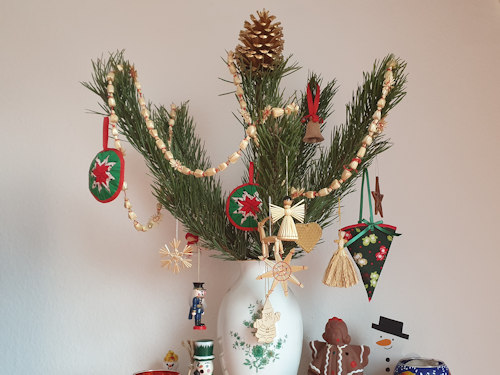
(An understated Barbarazweig from home)
Legend has it that on her way to imprisonment and eventual execution, the catholic saint, Barbara, caught her clothes in a roadside fruit tree, breaking off a twig. She took the twig with her to prison, where it flowered on the day her death sentence was passed.
On St. Barbara’s Day (December 4th), the Viennese put long twigs from a flowering tree – usually cherry or apple – in water in a warm location, then sit back and wait for the buds to burst into flower.
These days, evergreen trees often take the place of fruit trees as a source of branches (as in the photo above).
We often decorate the twigs with small baubles, ribbons and similar (much like you might decorate a Christmas tree).
This tradition dates back to at least the 13th century. It was said that young ladies could put several twigs in a vase, give each the name of a suitor, and the first to bloom was “the one”. I guess it’s an alternative to Tinder.
A tip for decoration shopping
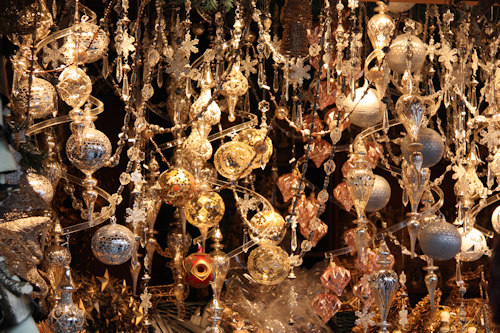
(Decorations at a market)
Vienna’s department stores usually have a Christmas bazaar during the Advent period. The decorations within cost considerably less than those at, for example, the Christmas markets.
Having said that, the markets have a wealth of unique decorations, handmade decorations, and similar that you probably won’t find easily (or at all) in stores or back home: look out, particularly, for glass baubles, carved wooden nativity figures, and decorated candles or tea light holders.
The seasonal store bazaars often stay open immediately after the Christmas public holidays, selling decorations at a significant discount. A good time to stock up for next year.
If you do visit Vienna during Christmas, take a look at my top tips for things to do or my broader guide to the Advent season.